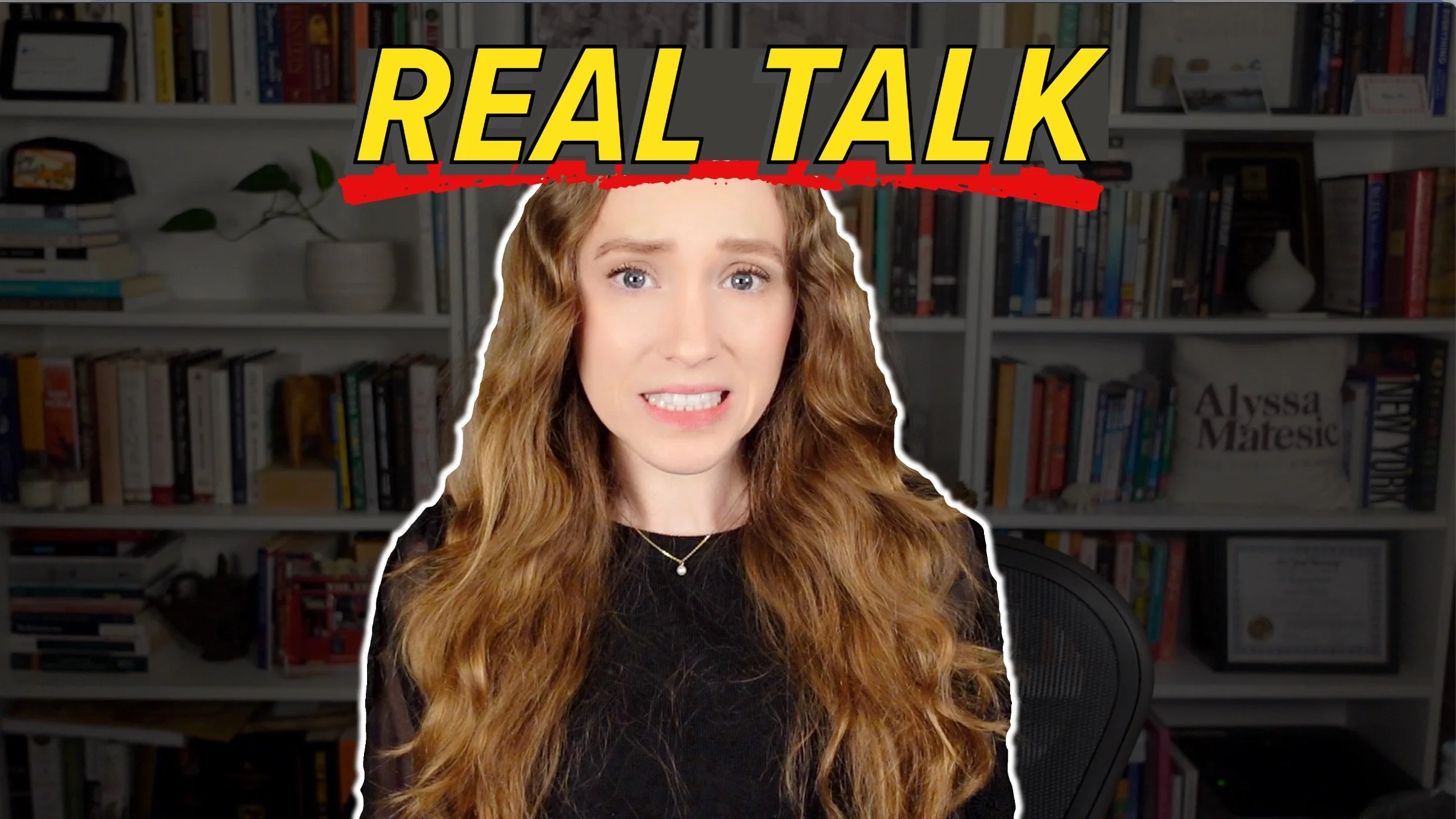How to End a Chapter to Make Your Book Unputdownable
HIT PLAY OR READ THE POST BELOW:
Here's the best compliment a writer could ever receive: ”I couldn't put your book down!” But how do you actually achieve that unputdownable quality in your book?
As a book editor, I'm constantly asking myself this question. It involves some combination of plotting, character development, and pacing — but as I was editing a client's manuscript recently, I had an aha moment where I discovered a simple trick that will supercharge your story with this propulsive quality. I'm going to break down exactly how you can apply this writing trick and go through some examples so you can see it in action.
The Secret to Writing Chapter Breaks That Keep Readers Reading
So, what is this amazing writing trick I discovered?
Craft suspenseful chapter endings.
Remember that every chapter ending gives the reader a choice whether to continue on with the story or put it down, so if the end of your chapter fizzles out and doesn't give them a reason to keep reading, they're likely not going to continue on with the story. That's why you want to inject some kind of suspense and intrigue into your chapter endings.
Make sure that every chapter leaves something unresolved. You want to give the reader no choice but to continue on with the story to see what happens next. After all, as humans we're hardwired to seek answers and resolution, so if you end your chapters with a question or an exciting turn of events or an unresolved emotion, you're naturally going to create that propulsive quality where readers can't help but want to read more.
So, rather than thinking of your chapter endings as a totally rounded conclusion, think of them as the start of the next scene — that's going to improve your pace and keep your reader engaged.
Look at each of your chapter endings and ask yourself, ”Would my reader be satisfied putting the book down here?” If the answer is yes, you want to rework your chapter ending to leave the reader wanting more.
How to End a Chapter With Suspense
Now let's talk about the three steps to take to land all of your chapter endings and make your story unputdownable as a result.
1. Make Each Chapter Substantive
The first is to make sure every chapter on its own is substantive. Before you refine your chapter endings, you have to make sure the chapter itself is fully developed. After all, you can't stick the landing if the chapter itself doesn't have much substance.
Remember that each chapter should contain its own mini plot arc: a beginning, middle and end. Your chapter might contain one continuous scene or it might contain a series of shorter scenes, but regardless, the chapter needs to materially progress the narrative forward in some way.
Ask yourself, “How is this chapter actually moving the plot or the characters forward?” Watch out for uneventful chapters where no actual progression happens. If nothing significant changes in a particular chapter, you might consider omitting it or combining it with a subsequent scene that has more substance. Something that can help immensely with ensuring every chapter contributes to the overarching narrative is reverse outlining.
Making sure that each chapter meaningfully progresses the narrative forward is going to make your story feel so much more intentionally crafted, which is what allows you to create that propulsive, “just one more chapter” experience for your reader.
2. Identify the Lingering Point of Tension
The second step in creating suspenseful chapter endings is to identify the lingering point of tension. Your chapter should meaningfully progress the story forward, but it shouldn't resolve everything. In fact, it should leave something unresolved because that's what's going to keep your reader engaged.
So, by the end of the chapter, you should either introduce a new obstacle for the characters to overcome or complicate an existing point of conflict. The chapter should end at a high point of tension and be emotionally charged. If it just fizzles out, that's when you run the risk of the reader putting the book down.
If nothing is happening in your chapter to create enough tension for you to end the scene at a high emotional point, then the chapter itself might not be doing the work that it needs to, and you should go back to step one.
Ask yourself, “Is the tension explored in this scene fully resolved by the end of it?” The answer should be no unless this is the final chapter of your book.
If your current chapter does resolve the tension, then you might consider ending it a bit earlier and then blending the resolution into the next chapter because that will more effectively preserve the suspense and pull the reader into the next scene.
3. Revise the Final Lines of the Chapter
The final step is to revise the final lines of the chapter to create that suspense. I'm not talking here about ending every chapter on a dramatic cliffhanger — in fact, if you overuse cliffhangers, the reader is going to quickly become tired of them. Often, subtler endings are even more effective.
Here are five tactical ways to create suspense at the end of your chapters:
Raise a question: This is the most obvious and straightforward way to pique the reader's interest in continuing on with the story to see how that question gets resolved. For example, you could end with a line like: But then she heard someone whisper her name from behind. Note that ending with a question doesn't mean you literally have to put a question into the text itself, but this line immediately raises questions for the reader. Who is whispering her name, and why? We're immediately intrigued to find out.
Create an obstacle: If you end your chapter by creating a problem for your character, we're naturally going to want to see how they overcome that obstacle. Here's an example of how this could look: The letter slipped through her fingers and into the storm drain. Presumably this letter was important to the character achieving their objective, so now we're curious to see what they're going to do since the letter has been lost.
Drop a bomb: This is the most dramatic way to end your chapters. It is a surprising reveal that changes everything. It can be incredibly effective, but you don't want to overuse this technique — save it just for the most important reveals in your story. You'll give the reader the feeling of a puzzle piece clicking into place, and we're naturally going to want to see the ramifications of this major development on the rest of the story. Here's an example of what it could look like: The handwriting was unmistakable — it was his mother's. This should resolve a point of tension that has been building throughout the rest of the story, and now we can't help but continue reading to see what happens once the characters acknowledge this reveal.
End with unresolved emotion: This is one of those subtler techniques that can be incredibly powerful and effective. With this method, you'll play on the reader's own emotion and their attachment to the characters. If the character feels some sort of inner conflict or unresolved emotion, we're naturally going to want to see how that plays out, especially if you already have established a connection between your reader and your character. Here’s an example of what it could look like: He shut the door behind him, but the words still echoed in his head: it's your fault. We can feel the emotional impact and interpersonal conflict in this moment, and that unresolved emotion creates a tension that will carry us into the following scenes.
Add a time constraint: Creating a ticking clock or a looming deadline is an easy way to naturally amplify the stakes and pace of your story, and it's going to create an atmosphere of tension that will keep the reader turning the pages. Here’s an example: She realized it had been a week since she last heard from him. A clap of thunder drew her attention to the window. The hurricane had arrived. In this example, the atmosphere of the storm amplifies the tension because we know that the character is looking for someone and presumably the storm is going to complicate that and make it even more important for them to be urgently found.
Now, no matter which technique you use to create suspense at the end of your chapters, you want to make sure that there's a payoff in the following scene. Don’t introduce a point of suspense and then resolve it too easily or drop it entirely because then you're going to erode the reader’s trust. The suspense needs to feel earned and feel like it belongs in the context of the plot.
For example, if you end your chapter with a mysterious knock at the door, and then at the start of the next chapter the reader learns it was just an Amazon delivery that has no ramifications on the rest of the story, they're going to feel cheated.
As you go back through your manuscript to revise your chapter endings, I recommend using a mix of these different techniques. You don't want to lean too much into just one technique over and over because then the reader will start to pick up on it and it will feel repetitive. But if you vary your chapter ending techniques, you'll keep the reader on the edge of their seat.
Examples of How to Write a Suspenseful Chapter Ending
Now that we know how to craft strong suspenseful chapter endings, let's go through two examples of bad chapter endings and how to revise them to make them more effective.
Here's an example of a boring, static chapter ending:
She finally drifted off to sleep.
Here’s a much more dynamic, engaging ending:
Just as her eyelids fluttered shut, the floorboards creaked.
It’s very natural, especially for newer writers, to begin a scene with a character waking up and/or end a scene with a character going to sleep because it feels like a natural starting and ending point. But a character drifting off into sleep doesn't really do anything to pique our curiosity to see what happens next.
Technically, the revised version still shows the character going off to sleep, but it introduces a question: What is causing the floorboards to creak? Is someone there? You’re naturally making us want to see what happens next.
Here’s another another example of a static chapter ending:
She smiled warmly at the guests as they descended onto the glittering ballroom floor. The gala had officially begun.
Here, the author sets the scene, but it doesn't feel like the plot is moving in any particular direction. The character is in a satisfied, content state. Here’s a more suspenseful and interesting ending:
Her smile fell when she caught sight of him across the glittering ballroom floor — with another woman on his arm.
Which chapter ending makes you more likely to read? The second ending, right? That’s because it introduces a conflict that we naturally want to see play out. We want to know who this other woman is and why the sight made the POV character’s smile fall.
As you revisit your own chapter endings, ask yourself if you're ending with your character in a satisfied or a dissatisfied state, because the dissatisfied state is often the more interesting one.
This example also shows how the conflict and tension in your chapter endings can be more subtle — this technique really isn't just for mysteries with life-or-death stakes; it applies to all novels across all genres.
Thanks so much for reading, and happy writing!





